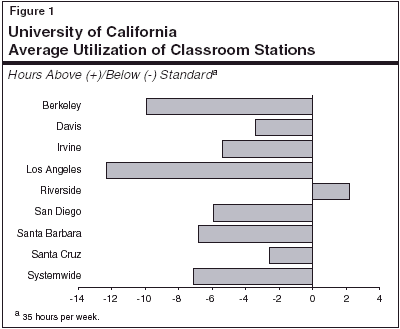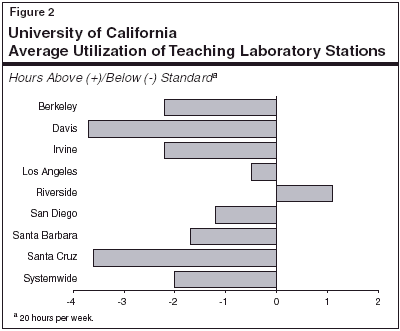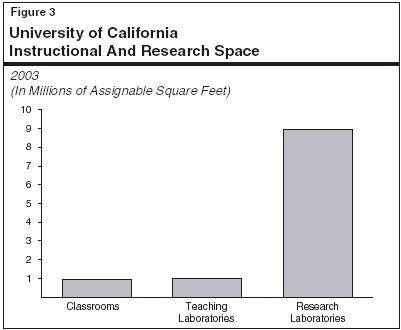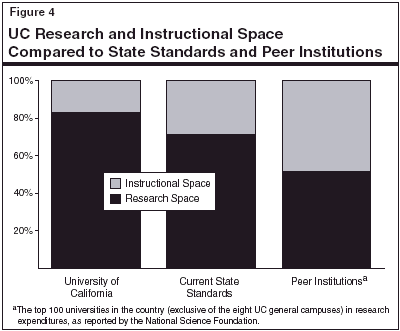Legislative Analyst's OfficeAnalysis of the 2003-04 Budget Bill |
University of California (6440)
The Governor proposes $307.5 million from the Higher Education Capital Outlay Bond Fund of 2002 for 38 projects, $3 million from the Higher Education Capital Outlay Bond Fund of 1998 for one project, and $11 million from the Public Buildings Construction Fund (lease-revenue bonds) for institutes for science and innovation. We recommend the Legislature reduce $6 million from two projects and recognize reductions totaling $63 million in future costs, as discussed in detail below.
UC Capital Outlay Plans Do Not Fully Reflect Year-Round Operation
We recommend the Legislature direct the University of California to amend its state-funded capital outlay plans to reflect full use of instructional facilities during summer term.
The Legislature has indicated its intent that the University of California increase summer enrollment in order to reduce the need to construct new instructional facilities. Chapter 383, Statutes of 2000 (AB 2409, Migden), found that year-round operation increased student access and could allow students to shorten their time-to-degree. The Supplemental Reports of the 2001-02 and 2002-03 Budget Acts expressed similar intent. The UC capital improvement program, however, continues to plan for construction of substantial new instructional facilities (classrooms and teaching laboratories). All of these new instructional facilities might not be needed if the campuses' existing instructional facilities were fully utilized in the summer.
The university plans to construct about 180,000 assignable square feet (asf) of instructional facilities in the next three years at an estimated cost of over $70 million. This is almost as much instructional space as is at the Santa Cruz campus. Alternatively, if facilities were fully utilized during summer term, the UC system could accommodate many more students without building new instructional facilities. Currently, UC is serving about 18,000 FTE students in the summer (primarily at the Los Angeles, Davis, Santa Barbara, and Berkeley campuses). This means the segment has enough instructional facilities to serve about 135,000 additional FTE students in the summer. Even with this excess instructional capacity, UC's plan is to ask the state to spend tens of millions of dollars constructing new instructional facilities—when utilizing existing facilities during the summer could accommodate additional students at no additional capital cost.
An important benefit of year-round operation of UC campuses is avoiding the capital cost of building new facilities solely to accommodate enrollment growth. The UC's capital improvement plan does not reflect the Legislature's intent that enrollment growth be accommodated through utilization of existing facilities during the summer, before constructing new facilities. We, therefore, recommend the Legislature direct UC to delete from its capital outlay plan the construction of instructional space that is intended to accommodate enrollment growth that could be accommodated in existing facilities during summer term.
UC Instructional Facilities Are Underutilized
We recommend the Legislature direct the University of California to utilize its instructional facilities at least as much as required by legislatively approved utilization standards.
The Legislature has established standards for utilization of instructional facilities (classrooms and teaching laboratories) by UC. For classrooms the standard is for each station (such as a desk in a classroom or a workspace in a teaching laboratory) to be occupied for instructional purposes 35 hours per week between the hours of 8:00 AM and 10:00 PM, Monday through Friday. The standard for teaching laboratories is 20 hours per week between 8:00 AM and 5:00 PM.
The UC reports biennially to the Legislature on its compliance with these standards. In its latest report (covering Fall 2001 utilization) the university reported that classroom stations are utilized about 28 hours per week and teaching laboratory stations about 18 hours per week. This means UC is using classrooms about 80 percent and teaching laboratories 90 percent of the time required by the Legislature's standards. Figures 1 and 2 (see next page) show that no campuses meet the Legislature's standards except for Riverside.
If UC utilized its existing instructional facilities just at the standard required by the Legislature, it could increase its instructional capacity by 11 percent or more. This means the university might be able to accommodate an additional 20,000 FTE students (almost as many students as attend the Santa Barbara campus) without constructing any new instructional facilities. This potential gain through better utilization would be in addition to the instructional capacity UC would gain by operating campuses year-round at full capacity. Accordingly, we recommend the Legislature direct UC to utilize its instructional facilities at least as much as required by legislatively approved standards.


UC Research Space Exceeds Standards
The UC has about 11 million asf of instruction and research facilities at its eight general campuses—about 9 million asf of which is research space. The remaining 2 million asf is instructional space consisting of classrooms, teaching laboratories and other unclassified space (see Figure 3).

Research Space Greatly Exceeds State Standards. The Legislature has adopted standards for UC research space which provide for over twice as much space for research as for instructional classrooms and teaching laboratories. These standards justify a need for about 5 million asf of research space based on projected 2003 enrollment. This means UC has about 4 million more asf of research space than is recommended by existing legislatively approved standards.
UC Has Significantly Greater Proportion of Research Space Than Comparable Institutions. We have examined the research and instructional space at leading research universities throughout the country to see how much of their total academic space (consisting of instructional plus research space) is devoted to research. We compared the proportions at these institutions to those at UC, and to what is allowable at UC under the legislatively approved research space standards. Data reported by the National Science Foundation indicate that the top 100 universities in the country in terms of research expenditures (exclusive of the eight UC general campuses) have about 50 percent of total academic space devoted to research. The UC, however, has about 80 percent of its academic space devoted to research. Under the legislatively approved re search space standards, about 70 percent of UC's total academic space would be devoted to research (see Figure 4).

This means the Legislature's existing standards for UC research space allow substantially more research space than at comparable institutions, and that existing research space at UC campuses is substantially more than both comparable institutions and that allowable under the Legislature's standards.
Projects Recommended for Reduction
Irvine: Biological Sciences Unit 3
We recommend the Legislature reduce $3,080,000 for development of preliminary plans and working drawings for the Biological Sciences Unit 3 building at the Irvine campus and recognize future costs of $10,153,000 because the campus has more research space than justified by legislatively approved guidelines. (Delete $3,080,000 from Item 6440-302-6026(9).)
The budget includes $3,592,000 for development of preliminary plans and working drawings for a 79,400 asf building with future cost of $52,280,000 for construction and equipment. The new building is to contain research space (74 percent), offices (19 percent), and a general assignment classroom (7 percent). Although three-fourths of the space would be dedicated for research, the segment indicates this building is needed to meet enrollment growth in the School of Biological Sciences.
The Irvine campus is projected to have about 800,000 asf of research space in 2006 and about 550,000 asf is justified under the legislatively approved space guidelines—an excess of about 45 percent. Since the campus has substantially more research space than justified by the Legislature's standards, we recommend the state fund only the office and classroom space.
As discussed earlier in this chapter, we recommend the Legislature fund construction of new buildings at UC campuses using construction cost guidelines (discussed in detail in the "Crosscutting Issues" section of this chapter). Figure 5 shows how the space is planned to be used in the new building and our recommendations as to the space and per asf costs.
When other costs that are not directly related to construction are included, our recommended funding is shown in Figure 6. This figure also compares our recommendation with the funding proposed in the budget.
Applying our recommendations reduces the budget proposal by $3.1 million (from $3.6 million to $512,000) and recognizes future state costs of $10.2 million (instead of $52.3 million). This will make about $45 million of additional funds available for other high priority projects in the three segments of higher education.
San Diego: Mayer Hall Addition and Renovation
We recommend the Legislature reduce $2,072,000 for development of preliminary plans and working drawings for the addition to Mayer Hall at the San Diego campus and recognize future costs of $15,470,000 because the campus has more research space than justified by legislatively approved guidelines. (Delete $2,036,000 from Item 6440-301-6028(16).)
The budget includes $3,559,000 for development of preliminary plans and working drawings for renovation of about 35,000 asf in Mayer Hall and construction of a 45,000 asf addition for the Department of Physics. The total cost of the project is $40 million. The renovation of Mayer Hall would increase the available space from 55,700 to 58,300 asf, including 33,800 asf (58 percent) of research space, 13,200 asf for offices (23 percent), and 11,300 asf for teaching laboratories (19 percent). The addition would provide 35,400 asf of research space (79 percent), 5,300 asf for offices (12 percent), and 4,300 asf (9 percent) for teaching laboratories.
As discussed above, we recommend research space be funded in accordance with the legislatively approved space standards and construction cost guidelines be applied. The San Diego campus is projected to have 1.2 million asf of research space in 2006, and about 1.1 million asf will be justified under legislatively approved space guidelines. Thus the campus is projected to have about 11 percent more research space in 2006 than is justified under the legislatively approved space guidelines. As with the prior issue, we recommend that the Legislature not fund the proposed research space. Figure 7 shows the costs of funding the remaining space, using our recommended cost guidelines.
When other costs not directly related to construction of the addition are included, our recommended funding is shown in Figure 8.
Applying our recommendations reduces the budget proposal by $2 million and recognizes future state costs of $15.5 million. This will make about $23 million of additional funds available for other high priority projects in the three segments of higher education.